Epidural Haematoma Case Study: Pathophysiology and Management
VerifiedAdded on 2021/02/19
|7
|1387
|93
Case Study
AI Summary
This case study presents a detailed analysis of a patient, Donald, suffering from a subacute epidural haematoma, focusing on the pathophysiology and management of acute and chronic occipital epidural haematomas. The report explores the various symptoms, including seizures, vision loss, and headaches, and discusses diagnostic methods such as CT scans, MRI, and EEG. The management section covers treatment techniques like surgery, medication, rehabilitative therapy, and home care. Additionally, the study investigates the link between alcoholism and epidural haematoma, explaining how alcohol can damage nerves and increase the risk of bleeding. It also delves into the pathophysiology of alcohol-induced epidural haematoma, detailing symptoms and the increased risk for individuals with a history of heavy alcohol intake. The case study concludes by emphasizing the importance of accurate diagnosis and appropriate treatment for managing this condition.
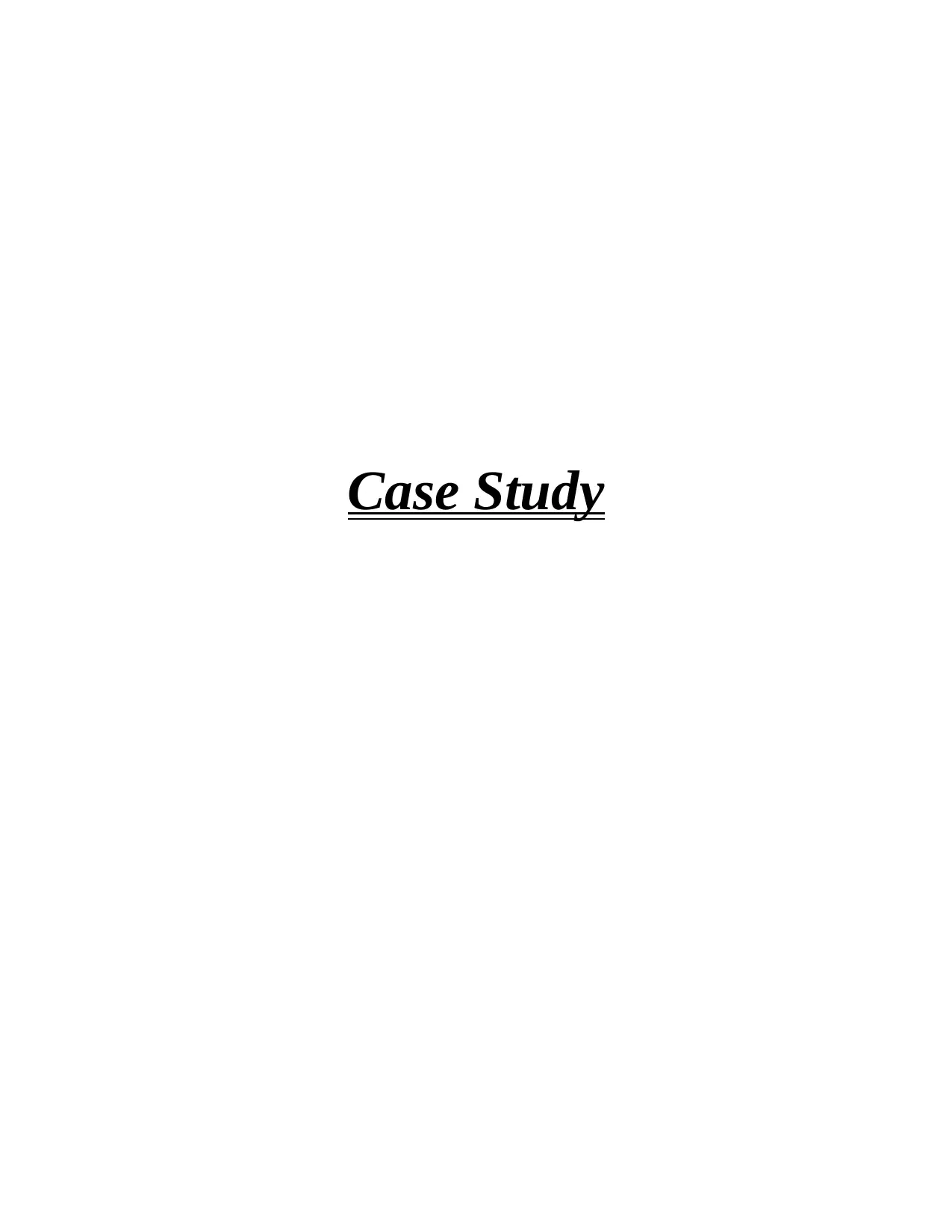
Case Study
Paraphrase This Document
Need a fresh take? Get an instant paraphrase of this document with our AI Paraphraser

Table of Contents
Introduction......................................................................................................................................1
Main body........................................................................................................................................1
Pathophysiology of acute and chronic occipital epidural
haematomas................................................................................................................................1
Management of acute and chronic occipital epidural haematomas.............................................1
Why an epidural haematoma might be common in alcoholism..................................................2
Pathophysiology of alcohol induced epidural haematoma..........................................................3
Conclusion.......................................................................................................................................3
References........................................................................................................................................4
Introduction......................................................................................................................................1
Main body........................................................................................................................................1
Pathophysiology of acute and chronic occipital epidural
haematomas................................................................................................................................1
Management of acute and chronic occipital epidural haematomas.............................................1
Why an epidural haematoma might be common in alcoholism..................................................2
Pathophysiology of alcohol induced epidural haematoma..........................................................3
Conclusion.......................................................................................................................................3
References........................................................................................................................................4

⊘ This is a preview!⊘
Do you want full access?
Subscribe today to unlock all pages.

Trusted by 1+ million students worldwide
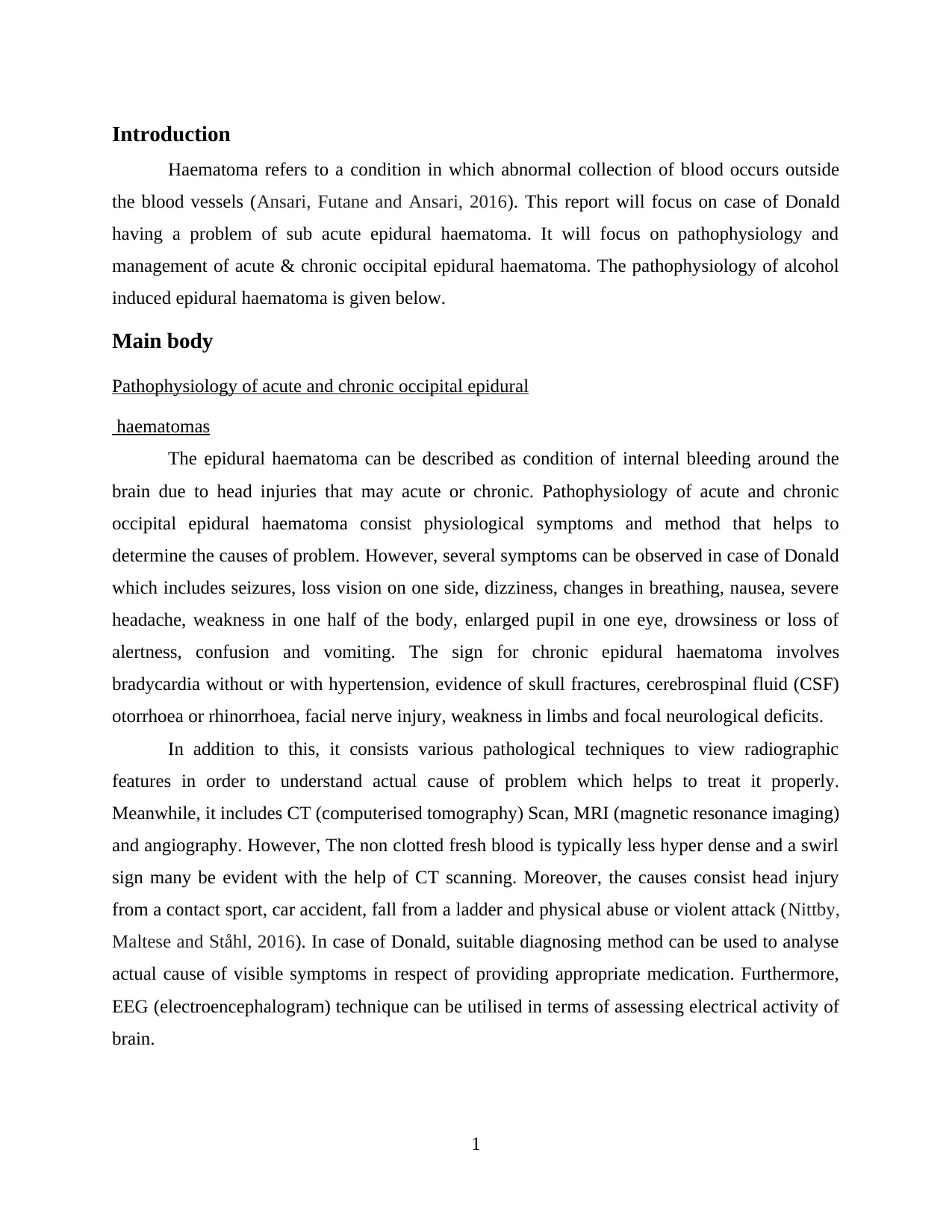
Introduction
Haematoma refers to a condition in which abnormal collection of blood occurs outside
the blood vessels (Ansari, Futane and Ansari, 2016). This report will focus on case of Donald
having a problem of sub acute epidural haematoma. It will focus on pathophysiology and
management of acute & chronic occipital epidural haematoma. The pathophysiology of alcohol
induced epidural haematoma is given below.
Main body
Pathophysiology of acute and chronic occipital epidural
haematomas
The epidural haematoma can be described as condition of internal bleeding around the
brain due to head injuries that may acute or chronic. Pathophysiology of acute and chronic
occipital epidural haematoma consist physiological symptoms and method that helps to
determine the causes of problem. However, several symptoms can be observed in case of Donald
which includes seizures, loss vision on one side, dizziness, changes in breathing, nausea, severe
headache, weakness in one half of the body, enlarged pupil in one eye, drowsiness or loss of
alertness, confusion and vomiting. The sign for chronic epidural haematoma involves
bradycardia without or with hypertension, evidence of skull fractures, cerebrospinal fluid (CSF)
otorrhoea or rhinorrhoea, facial nerve injury, weakness in limbs and focal neurological deficits.
In addition to this, it consists various pathological techniques to view radiographic
features in order to understand actual cause of problem which helps to treat it properly.
Meanwhile, it includes CT (computerised tomography) Scan, MRI (magnetic resonance imaging)
and angiography. However, The non clotted fresh blood is typically less hyper dense and a swirl
sign many be evident with the help of CT scanning. Moreover, the causes consist head injury
from a contact sport, car accident, fall from a ladder and physical abuse or violent attack (Nittby,
Maltese and Ståhl, 2016). In case of Donald, suitable diagnosing method can be used to analyse
actual cause of visible symptoms in respect of providing appropriate medication. Furthermore,
EEG (electroencephalogram) technique can be utilised in terms of assessing electrical activity of
brain.
1
Haematoma refers to a condition in which abnormal collection of blood occurs outside
the blood vessels (Ansari, Futane and Ansari, 2016). This report will focus on case of Donald
having a problem of sub acute epidural haematoma. It will focus on pathophysiology and
management of acute & chronic occipital epidural haematoma. The pathophysiology of alcohol
induced epidural haematoma is given below.
Main body
Pathophysiology of acute and chronic occipital epidural
haematomas
The epidural haematoma can be described as condition of internal bleeding around the
brain due to head injuries that may acute or chronic. Pathophysiology of acute and chronic
occipital epidural haematoma consist physiological symptoms and method that helps to
determine the causes of problem. However, several symptoms can be observed in case of Donald
which includes seizures, loss vision on one side, dizziness, changes in breathing, nausea, severe
headache, weakness in one half of the body, enlarged pupil in one eye, drowsiness or loss of
alertness, confusion and vomiting. The sign for chronic epidural haematoma involves
bradycardia without or with hypertension, evidence of skull fractures, cerebrospinal fluid (CSF)
otorrhoea or rhinorrhoea, facial nerve injury, weakness in limbs and focal neurological deficits.
In addition to this, it consists various pathological techniques to view radiographic
features in order to understand actual cause of problem which helps to treat it properly.
Meanwhile, it includes CT (computerised tomography) Scan, MRI (magnetic resonance imaging)
and angiography. However, The non clotted fresh blood is typically less hyper dense and a swirl
sign many be evident with the help of CT scanning. Moreover, the causes consist head injury
from a contact sport, car accident, fall from a ladder and physical abuse or violent attack (Nittby,
Maltese and Ståhl, 2016). In case of Donald, suitable diagnosing method can be used to analyse
actual cause of visible symptoms in respect of providing appropriate medication. Furthermore,
EEG (electroencephalogram) technique can be utilised in terms of assessing electrical activity of
brain.
1
Paraphrase This Document
Need a fresh take? Get an instant paraphrase of this document with our AI Paraphraser
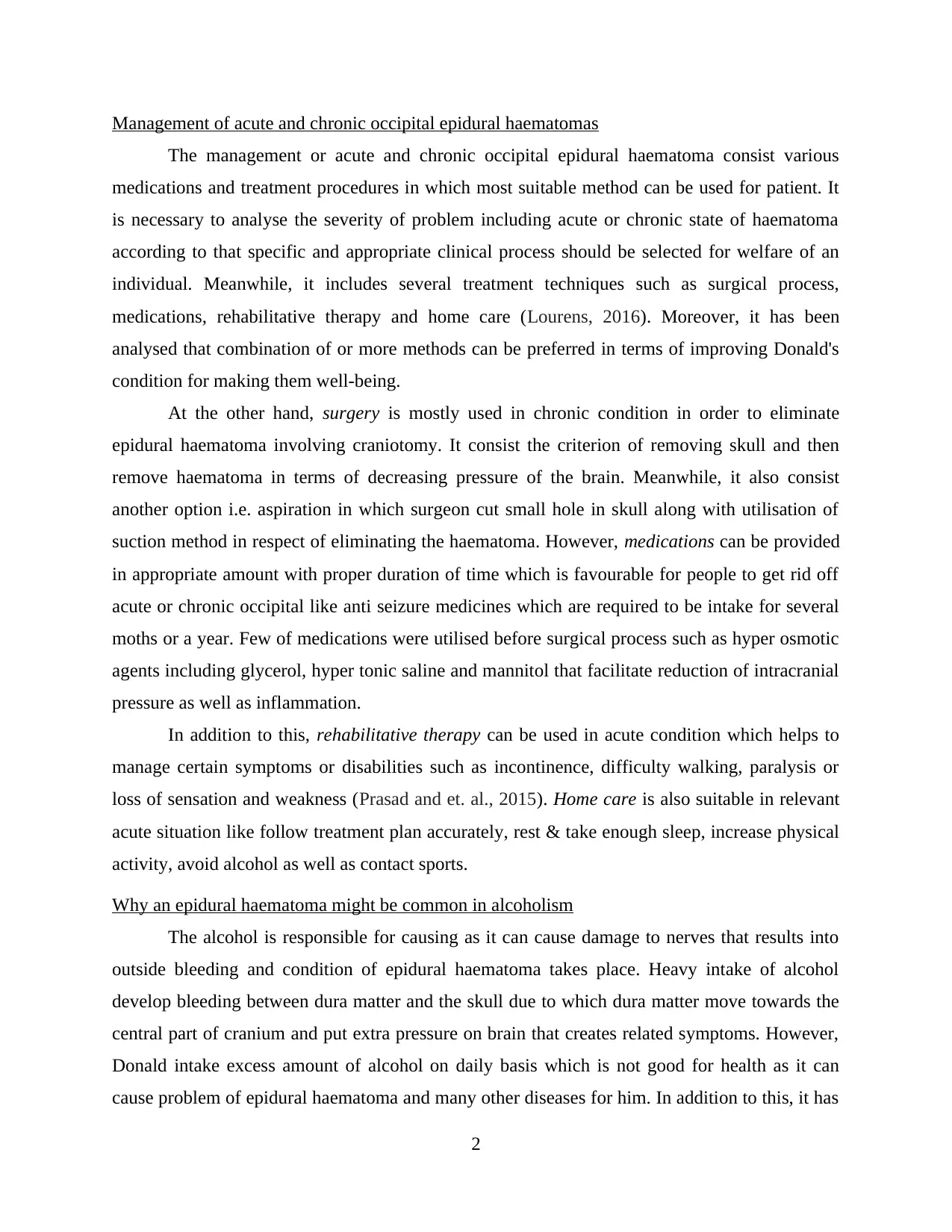
Management of acute and chronic occipital epidural haematomas
The management or acute and chronic occipital epidural haematoma consist various
medications and treatment procedures in which most suitable method can be used for patient. It
is necessary to analyse the severity of problem including acute or chronic state of haematoma
according to that specific and appropriate clinical process should be selected for welfare of an
individual. Meanwhile, it includes several treatment techniques such as surgical process,
medications, rehabilitative therapy and home care (Lourens, 2016). Moreover, it has been
analysed that combination of or more methods can be preferred in terms of improving Donald's
condition for making them well-being.
At the other hand, surgery is mostly used in chronic condition in order to eliminate
epidural haematoma involving craniotomy. It consist the criterion of removing skull and then
remove haematoma in terms of decreasing pressure of the brain. Meanwhile, it also consist
another option i.e. aspiration in which surgeon cut small hole in skull along with utilisation of
suction method in respect of eliminating the haematoma. However, medications can be provided
in appropriate amount with proper duration of time which is favourable for people to get rid off
acute or chronic occipital like anti seizure medicines which are required to be intake for several
moths or a year. Few of medications were utilised before surgical process such as hyper osmotic
agents including glycerol, hyper tonic saline and mannitol that facilitate reduction of intracranial
pressure as well as inflammation.
In addition to this, rehabilitative therapy can be used in acute condition which helps to
manage certain symptoms or disabilities such as incontinence, difficulty walking, paralysis or
loss of sensation and weakness (Prasad and et. al., 2015). Home care is also suitable in relevant
acute situation like follow treatment plan accurately, rest & take enough sleep, increase physical
activity, avoid alcohol as well as contact sports.
Why an epidural haematoma might be common in alcoholism
The alcohol is responsible for causing as it can cause damage to nerves that results into
outside bleeding and condition of epidural haematoma takes place. Heavy intake of alcohol
develop bleeding between dura matter and the skull due to which dura matter move towards the
central part of cranium and put extra pressure on brain that creates related symptoms. However,
Donald intake excess amount of alcohol on daily basis which is not good for health as it can
cause problem of epidural haematoma and many other diseases for him. In addition to this, it has
2
The management or acute and chronic occipital epidural haematoma consist various
medications and treatment procedures in which most suitable method can be used for patient. It
is necessary to analyse the severity of problem including acute or chronic state of haematoma
according to that specific and appropriate clinical process should be selected for welfare of an
individual. Meanwhile, it includes several treatment techniques such as surgical process,
medications, rehabilitative therapy and home care (Lourens, 2016). Moreover, it has been
analysed that combination of or more methods can be preferred in terms of improving Donald's
condition for making them well-being.
At the other hand, surgery is mostly used in chronic condition in order to eliminate
epidural haematoma involving craniotomy. It consist the criterion of removing skull and then
remove haematoma in terms of decreasing pressure of the brain. Meanwhile, it also consist
another option i.e. aspiration in which surgeon cut small hole in skull along with utilisation of
suction method in respect of eliminating the haematoma. However, medications can be provided
in appropriate amount with proper duration of time which is favourable for people to get rid off
acute or chronic occipital like anti seizure medicines which are required to be intake for several
moths or a year. Few of medications were utilised before surgical process such as hyper osmotic
agents including glycerol, hyper tonic saline and mannitol that facilitate reduction of intracranial
pressure as well as inflammation.
In addition to this, rehabilitative therapy can be used in acute condition which helps to
manage certain symptoms or disabilities such as incontinence, difficulty walking, paralysis or
loss of sensation and weakness (Prasad and et. al., 2015). Home care is also suitable in relevant
acute situation like follow treatment plan accurately, rest & take enough sleep, increase physical
activity, avoid alcohol as well as contact sports.
Why an epidural haematoma might be common in alcoholism
The alcohol is responsible for causing as it can cause damage to nerves that results into
outside bleeding and condition of epidural haematoma takes place. Heavy intake of alcohol
develop bleeding between dura matter and the skull due to which dura matter move towards the
central part of cranium and put extra pressure on brain that creates related symptoms. However,
Donald intake excess amount of alcohol on daily basis which is not good for health as it can
cause problem of epidural haematoma and many other diseases for him. In addition to this, it has
2
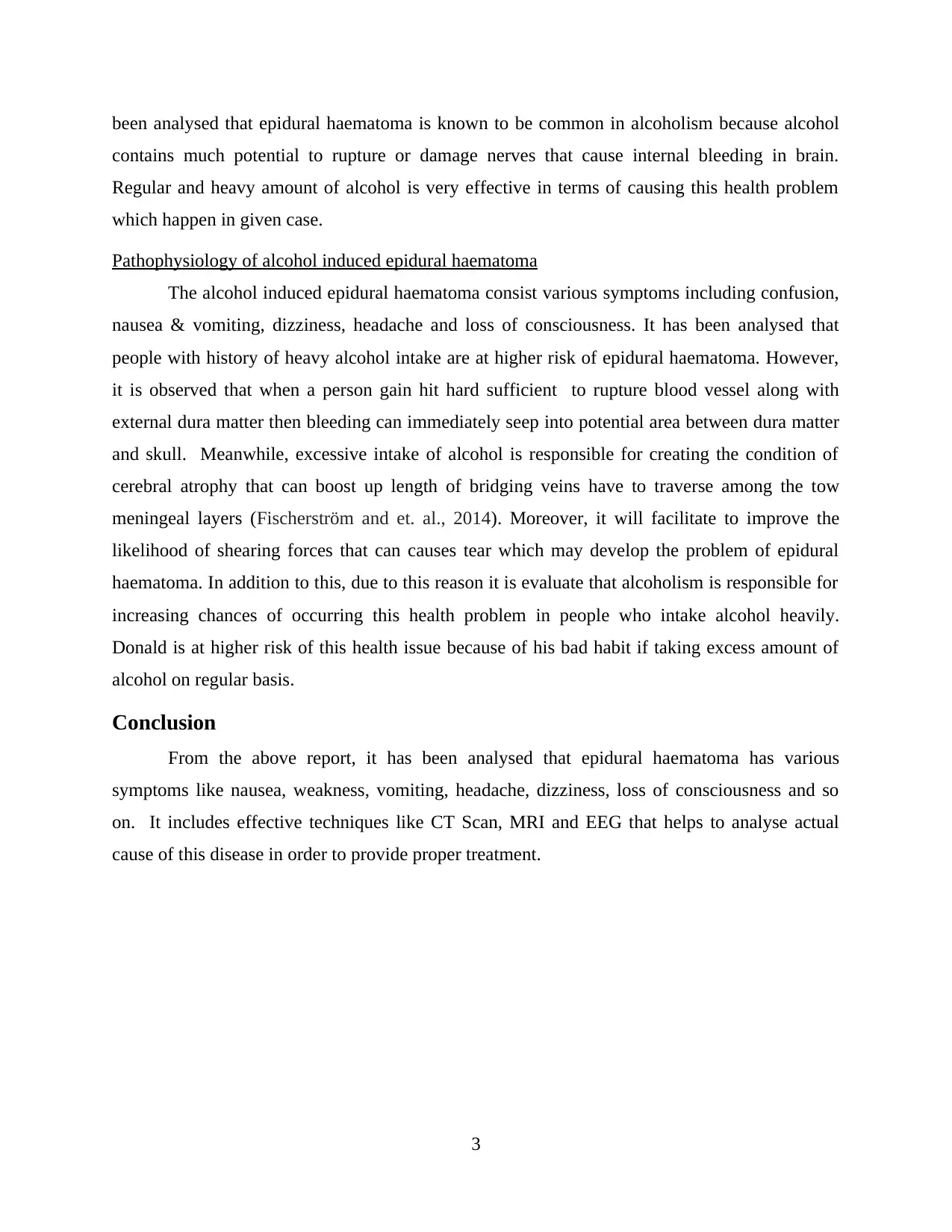
been analysed that epidural haematoma is known to be common in alcoholism because alcohol
contains much potential to rupture or damage nerves that cause internal bleeding in brain.
Regular and heavy amount of alcohol is very effective in terms of causing this health problem
which happen in given case.
Pathophysiology of alcohol induced epidural haematoma
The alcohol induced epidural haematoma consist various symptoms including confusion,
nausea & vomiting, dizziness, headache and loss of consciousness. It has been analysed that
people with history of heavy alcohol intake are at higher risk of epidural haematoma. However,
it is observed that when a person gain hit hard sufficient to rupture blood vessel along with
external dura matter then bleeding can immediately seep into potential area between dura matter
and skull. Meanwhile, excessive intake of alcohol is responsible for creating the condition of
cerebral atrophy that can boost up length of bridging veins have to traverse among the tow
meningeal layers (Fischerström and et. al., 2014). Moreover, it will facilitate to improve the
likelihood of shearing forces that can causes tear which may develop the problem of epidural
haematoma. In addition to this, due to this reason it is evaluate that alcoholism is responsible for
increasing chances of occurring this health problem in people who intake alcohol heavily.
Donald is at higher risk of this health issue because of his bad habit if taking excess amount of
alcohol on regular basis.
Conclusion
From the above report, it has been analysed that epidural haematoma has various
symptoms like nausea, weakness, vomiting, headache, dizziness, loss of consciousness and so
on. It includes effective techniques like CT Scan, MRI and EEG that helps to analyse actual
cause of this disease in order to provide proper treatment.
3
contains much potential to rupture or damage nerves that cause internal bleeding in brain.
Regular and heavy amount of alcohol is very effective in terms of causing this health problem
which happen in given case.
Pathophysiology of alcohol induced epidural haematoma
The alcohol induced epidural haematoma consist various symptoms including confusion,
nausea & vomiting, dizziness, headache and loss of consciousness. It has been analysed that
people with history of heavy alcohol intake are at higher risk of epidural haematoma. However,
it is observed that when a person gain hit hard sufficient to rupture blood vessel along with
external dura matter then bleeding can immediately seep into potential area between dura matter
and skull. Meanwhile, excessive intake of alcohol is responsible for creating the condition of
cerebral atrophy that can boost up length of bridging veins have to traverse among the tow
meningeal layers (Fischerström and et. al., 2014). Moreover, it will facilitate to improve the
likelihood of shearing forces that can causes tear which may develop the problem of epidural
haematoma. In addition to this, due to this reason it is evaluate that alcoholism is responsible for
increasing chances of occurring this health problem in people who intake alcohol heavily.
Donald is at higher risk of this health issue because of his bad habit if taking excess amount of
alcohol on regular basis.
Conclusion
From the above report, it has been analysed that epidural haematoma has various
symptoms like nausea, weakness, vomiting, headache, dizziness, loss of consciousness and so
on. It includes effective techniques like CT Scan, MRI and EEG that helps to analyse actual
cause of this disease in order to provide proper treatment.
3
⊘ This is a preview!⊘
Do you want full access?
Subscribe today to unlock all pages.

Trusted by 1+ million students worldwide
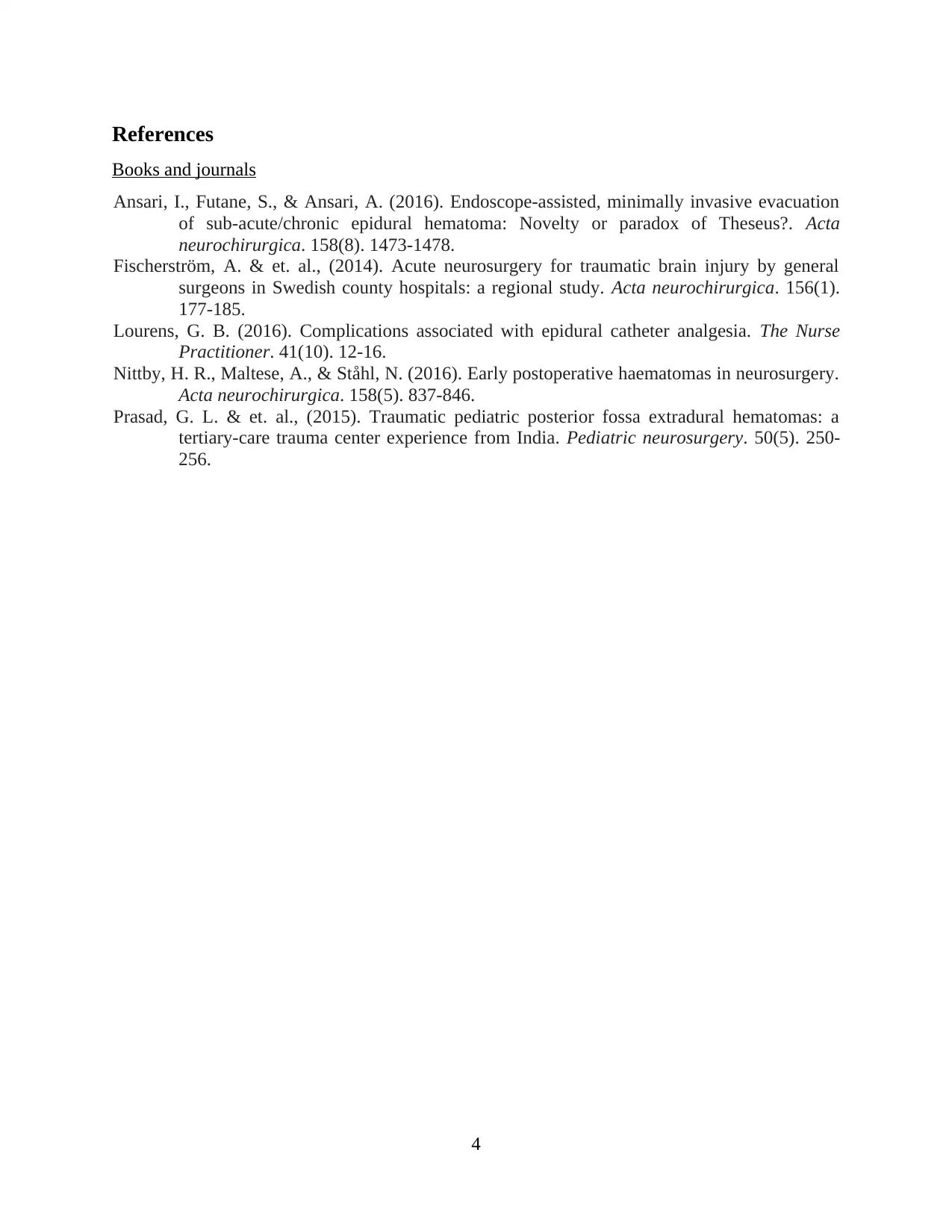
References
Books and journals
Ansari, I., Futane, S., & Ansari, A. (2016). Endoscope-assisted, minimally invasive evacuation
of sub-acute/chronic epidural hematoma: Novelty or paradox of Theseus?. Acta
neurochirurgica. 158(8). 1473-1478.
Fischerström, A. & et. al., (2014). Acute neurosurgery for traumatic brain injury by general
surgeons in Swedish county hospitals: a regional study. Acta neurochirurgica. 156(1).
177-185.
Lourens, G. B. (2016). Complications associated with epidural catheter analgesia. The Nurse
Practitioner. 41(10). 12-16.
Nittby, H. R., Maltese, A., & Ståhl, N. (2016). Early postoperative haematomas in neurosurgery.
Acta neurochirurgica. 158(5). 837-846.
Prasad, G. L. & et. al., (2015). Traumatic pediatric posterior fossa extradural hematomas: a
tertiary-care trauma center experience from India. Pediatric neurosurgery. 50(5). 250-
256.
4
Books and journals
Ansari, I., Futane, S., & Ansari, A. (2016). Endoscope-assisted, minimally invasive evacuation
of sub-acute/chronic epidural hematoma: Novelty or paradox of Theseus?. Acta
neurochirurgica. 158(8). 1473-1478.
Fischerström, A. & et. al., (2014). Acute neurosurgery for traumatic brain injury by general
surgeons in Swedish county hospitals: a regional study. Acta neurochirurgica. 156(1).
177-185.
Lourens, G. B. (2016). Complications associated with epidural catheter analgesia. The Nurse
Practitioner. 41(10). 12-16.
Nittby, H. R., Maltese, A., & Ståhl, N. (2016). Early postoperative haematomas in neurosurgery.
Acta neurochirurgica. 158(5). 837-846.
Prasad, G. L. & et. al., (2015). Traumatic pediatric posterior fossa extradural hematomas: a
tertiary-care trauma center experience from India. Pediatric neurosurgery. 50(5). 250-
256.
4
1 out of 7
Related Documents
Your All-in-One AI-Powered Toolkit for Academic Success.
+13062052269
info@desklib.com
Available 24*7 on WhatsApp / Email
![[object Object]](/_next/static/media/star-bottom.7253800d.svg)
Unlock your academic potential
Copyright © 2020–2025 A2Z Services. All Rights Reserved. Developed and managed by ZUCOL.





